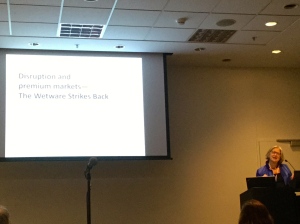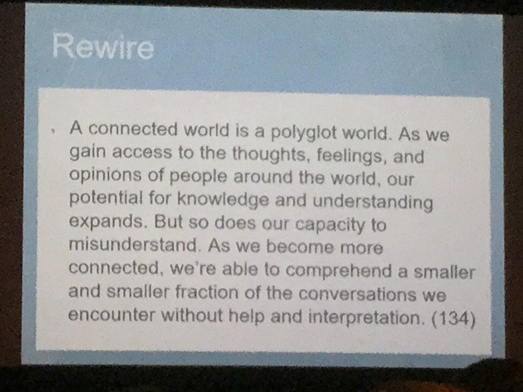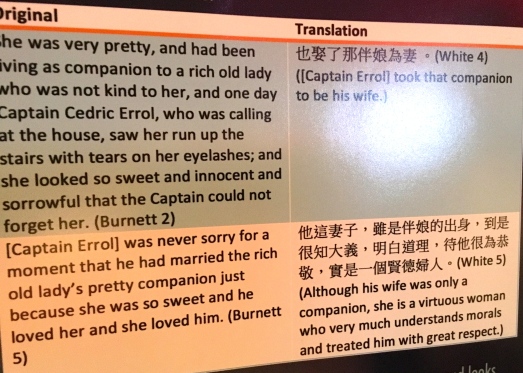I’m not quite a conference virgin – I attended IAPTI’s 2015 event in Bordeaux – but living where I do makes it difficult to attend international events, so FIT 2017 was only my second-ever translation conference, and with approximately 750 delegates from all over the world it was certainly of an impressive size. Held in Brisbane’s riverside Convention Centre, its antipodean location attracted a fair number of Australasian and Asian delegates, as well as some sign language professionals following the pre-congress ratification of a Memorandum of Understanding with the World Association of Sign Language Interpreters (WASLI).
The theme for this triennial congress was Disruption and Diversification, and after the opening speeches and a traditional Aboriginal ‘Welcome to Country’ that had me tapping my feet, the first plenary was by four members of the Aboriginal Interpreters Service on ‘Building the confidence to be an Aboriginal interpreter’. These presentations turned out to be one of the highlights of the first day, and Director Colleen Rosas struck a chord with me when she mentioned that some language service providers still think there’s only one Aboriginal language – there’s actually about 150 of them (I face the same problem with many LSPs’ ignorance of the fact that more than one Creole language exists in the world), and English can be the seventh language for some speakers.

Lighting a fire, part of the Aboriginal welcome to country
This was followed by well-known scholar Prof. Anthony Pym‘s keynote address ‘Translators do more than translate’, in which he reminded us that translators sell more than words, we sell trust (for inward communication) and communicative effect (for outward communication). After lunch the difficult decisions started, with up to 10 parallel slots at a time to choose from. I attended a live but remote presentation, ‘Moulding Our Future’, by Jost Zetzsche who prompted us to be compelling when we communicate, and which he ended by encouraging us to tweet to GoogleDoodles requesting they join the UN in honouring International Translation Day on September 30th.
.@GoogleDoodles: Please join the UN in honoring translation and translators on 9-30 (https://t.co/dwNBxUeiS9). Translators: Retweet!
— Jeromobot (@Jeromobot) May 24, 2017
The day ended with FIT’s prize ceremony, and the evening was then spent networking at a showboat river cruise.

One of the showboats we cruised the river on
The second day was jam-packed with presentations, interspersed with a late-morning keynote by Prof. Jemina Napier – the first-ever to be given in sign language at a FIT congress. It was fascinating to learn that there are 138 different signed languages in the world, that British Sign Language and Auslan only have about 70% of signs in common, and worldwide it’s estimated there are 25-30,000 signed language interpreters. Paediatrician and researcher Dr Glenn Flores delivered an information-packed plenary address, reminding us that the use of professional healthcare interpreters leads to reduced costs and better use of resources. One of his significant findings is that it is the hours of training (ideally at least 100 hours) that reduce medical interpreters’ errors, and not their years of experience.

Some examples of faulty medical interpreting with clinical consequences
Amongst the day’s presentations was ‘Disruption and premium markets—The Wetware Strikes Back’ by the inspirational Chris Durban, about which I could almost write a separate blog post, but for the sake of brevity: time, wetware (the brain), and talent are all essential factors if the aim is high quality translation. She informed us of the ways forward, pleaded for more research on non-scalable skillsets, and on a final half-humorous note suggested we emulate world No. 1 tennis player Rafael Nadal by always practicing, being precise, knowing all of the terrain, and being fit for the job. Later on in the day Chris was also part of a panel on Business Intelligence, and she pointed out that most clients don’t have a problem with translators signing their work, it’s us translators that may have a problem! The day ended with a Gala dinner at a nearby hotel.

Chris Durban presenting The Wetware Strikes Back
The third and final day opened with a disruptive keynote address by writer and anthropologist Dr Sarah Kendzior, ‘Dissent and Dictatorship in the Digital Age,’ about language, politics, and digital media. She made many important points, including the fact that constraint of language is constraint of power (taking the example of Uzbekistan), social media alone cannot override linguistic hierarchy and the language barrier, digital translation is not neutral, and digital media is not a panacea of democracy: human mediation is vital. Michael Cronin delivered the keynote ‘Why Translation Should Not Cost the Earth: Towards Geocentric Translation Studies’ and highlighted the fact that in a world of digital cosmopolitanism, translators are the supreme examples of cultural mediators; sustainable translation needs to avoid human resource extractivism, which is often hidden under a veneer of emancipation.

Digital cosmopolitanism – translators are the supreme example of cultural mediators
I enjoyed some of the day’s individual sessions too, including ‘Murakami Haruki as a Writer and Translator’, ‘The Signs Inform, the Readers React — A Study of Readers’ Reaction to the English Translations of the Commercial Signs in a Chinese Community in Australia’ and ‘Translation Quality and Cross‐Cultural Allowance in Translating into a Foreign Language’ which confirmed that translators translating into their non-native language(s) often lack self-awareness of the quality level of their translations. Lunch was followed by an interesting poster session – I was particularly struck by a poster illustrating what happened when an early 20th-century American missionary, Laura M. White, translated Little Lord Fauntleroy into Chinese.

What happens when an American missionary, Laura M. White, translated Little Lord Fauntleroy into Chinese
The Congress drew to a close, having run like clockwork thanks to all the hard work of the organising team, headed by Sam Berner. Proceedings concluded with outgoing President Henry Liu introducing the new FIT council members and his successor: Kevin Quirk, based in Norway. With apologies to the simultaneous interpreters, the latter (disruptively?) delivered part of his inaugural address in the form of a long rhyming poem. Will he compose another one for the next FIT Congress, to be held in Cuba in late 2020, I wonder?
Further reading:
- The official FIT press release following the congress
- Article by Rodolfo Maslias, Head of Terminology Coordination at the European Parliament.
- Article by John Jamieson of NZTC
- Blog post by Tea Dietterich, Chair of the XXI FIT World Congress 2017

Thank you, Catherine, for these insights on content and cud of the Brisbane gathering (lovely place). Especially your views on Chris Durban’s positions.
It was from Chris that I learned that whether one is a translator or writer or editor (and all variables), it can be good to describe oneself as a “premium writer”. For that is what one is. She passed that on to me at a wondrous workshop on ‘Style Matters’ held in Barcelona in 2011 by MET. You and I met at another MET event, 2013? Many thanks for your ever useful newsletters.
– Paul
I’m afraid I haven’t had the pleasure of attending any MET events yet, so I don’t think we’ve met.
Thank you, Catherine. It seems you have forgotten no one except the people who made it happen 🙂 Oh, well, we must have been truly invisible. Glad you enjoyed it.
You’re quite right to pull me up on that, Sam. I thanked the organising team in tweets at the end of the congress, but not in this blog post. That’s now rectified 🙂
Pingback: Around the web – July & August 2017 | A Smart Translator's Reunion
Pingback: Around the web – March 2018 | A Smart Translator's Reunion
Pingback: Around the web – May 2019 | A Smart Translator's Reunion
Pingback: Around the web – March 2023 | A Smart Translator's Reunion